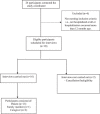Patient perceptions of in-hospital laboratory blood testing: A patient-oriented and patient co-designed qualitative study
- PMID: 37751312
- PMCID: PMC10726148
- DOI: 10.1111/hex.13880
Patient perceptions of in-hospital laboratory blood testing: A patient-oriented and patient co-designed qualitative study
Abstract
Background: Indiscriminate use of laboratory blood testing in hospitals contributes to patient discomfort and healthcare waste. Patient engagement in low-value healthcare can help reduce overuse. Understanding patient experience is necessary to identify opportunities to improve patient engagement with in-hospital laboratory testing.
Objectives: To understand patient experience with the process of in-hospital laboratory blood testing.
Methods: We used a qualitative study design via semistructured interviews conducted online or over the phone. Participants were adult patients or family members/caregivers (≥18 years of age) with a recent (within 12 months of interview) experience of hospitalization in Alberta or British Columbia, Canada. We identified participants through convenience sampling and conducted interviews between May 2021 and June 2022. We analysed transcripts using thematic content analysis. Recruitment was continued until code saturation was reached.
Results: We interviewed 16 participants (13 patients, 1 family member and 2 caregivers). We identified four themes from patients' experiences of in-hospital laboratory blood testing: (i) patients need information from healthcare teams about expected blood testing processes, (ii) blood draw processes should consider patient comfort and preferences, (iii) patients want information from their healthcare teams about the rationale and frequency of blood testing and (iv) patients need information on how their testing results affect their medical care.
Conclusion: Current laboratory testing processes in hospitals do not facilitate shared decision-making and patient engagement. Patient engagement with laboratory testing in hospitals requires an empathetic healthcare team that provides clear communication regarding testing procedures, rationale and results, while considering patient preferences and offering opportunities for involvement.
Patient or public contribution: We interviewed 16 patients and/or family members/caregivers regarding their in-hospital laboratory blood testing experiences. Our findings show correlations between patient needs and patient recommendations to make testing processes more patient-centred. To bring a lived-experience lens to this study, we formed a Patient Advisory Council with 9-11 patient research partners. Our patient research partners informed the research design, co-developed participant recruitment strategies, co-conducted data collection and informed the data analysis. Some of our patient research partners are co-authors of this manuscript.
Keywords: blood testing in hospitals; laboratory testing in hospitals; patient experience; patient‐oriented research.
© 2023 The Authors. Health Expectations published by John Wiley & Sons Ltd.
Conflict of interest statement
The authors declare no conflict of interest.
Figures
Similar articles
-
Patient, family member and caregiver engagement in shaping policy for primary health care teams in three Canadian Provinces.Health Expect. 2022 Aug;25(4):1730-1740. doi: 10.1111/hex.13516. Epub 2022 Jun 15. Health Expect. 2022. PMID: 35702988 Free PMC article.
-
The patient experience of patient-centered communication with nurses in the hospital setting: a qualitative systematic review protocol.JBI Database System Rev Implement Rep. 2015 Jan;13(1):76-87. doi: 10.11124/jbisrir-2015-1072. JBI Database System Rev Implement Rep. 2015. PMID: 26447009
-
Patient and caregiver perspectives on virtual care: a patient-oriented qualitative study.CMAJ Open. 2022 Mar 1;10(1):E165-E172. doi: 10.9778/cmajo.20210065. Print 2022 Jan-Mar. CMAJ Open. 2022. PMID: 35232815 Free PMC article.
-
Healthcare stakeholders' perceptions and experiences of factors affecting the implementation of critical care telemedicine (CCT): qualitative evidence synthesis.Cochrane Database Syst Rev. 2021 Feb 18;2(2):CD012876. doi: 10.1002/14651858.CD012876.pub2. Cochrane Database Syst Rev. 2021. PMID: 33599282 Free PMC article.
-
A rapid realist review of patient engagement in patient-oriented research and health care system impacts: part one.Res Involv Engagem. 2021 Oct 10;7(1):72. doi: 10.1186/s40900-021-00299-6. Res Involv Engagem. 2021. PMID: 34629118 Free PMC article. Review.
Cited by
-
Re-Purposing the Ordering of Routine Laboratory Tests in Hospitalized Medical Patients (RePORT): protocol for a multicenter stepped-wedge cluster randomised trial to evaluate the impact of a multicomponent intervention bundle to reduce laboratory test over-utilization.Implement Sci. 2024 Jul 2;19(1):45. doi: 10.1186/s13012-024-01376-6. Implement Sci. 2024. PMID: 38956637 Free PMC article.
-
Using Human-Centred Design to Codesign Patient Engagement Tools With a Patient Advisory Council: Successes and Challenges.Health Expect. 2025 Apr;28(2):e70230. doi: 10.1111/hex.70230. Health Expect. 2025. PMID: 40088008 Free PMC article.
References
-
- Baumann BM, Chen EH, Mills AM, et al. Patient perceptions of computed tomographic imaging and their understanding of radiation risk and exposure. Ann Emerg Med. 2011;58(1):1‐7. - PubMed
-
- O'Connor P, Detsky AS, Tansey C, Kucharczyk W. Effect of diagnostic testing for multiple sclerosis on patient health perceptions. Arch Neurol. 1994;51(1):46‐51. - PubMed
-
- Naugler C, Wyonch R. What the doctor ordered: improving the use and value of laboratory testing. 2019. Accessed February 6, 2023. https://www.cdhowe.org/public-policy-research/what-doctor-ordered-improv...
Publication types
MeSH terms
Grants and funding
LinkOut - more resources
Full Text Sources



